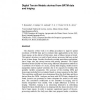Free Online Productivity Tools
i2Speak
i2Symbol
i2OCR
iTex2Img
iWeb2Print
iWeb2Shot
i2Type
iPdf2Split
iPdf2Merge
i2Bopomofo
i2Arabic
i2Style
i2Image
i2PDF
iLatex2Rtf
Sci2ools
3DGIS
2006
Springer
2006
Springer
Digital Terrain Models Derived from SRTM Data and Kriging
The objective of this work is to define procedures to improve spatial resolution of SRTM data and to evaluate their applicability in the Serra Negra region, in the district of Patrocínio, state of Minas Gerais in Brazil. The region's structure is a result of past tectonic processes that have arched it into a dome shape. Besides the already existing agriculture exploitation, Serra Negra also has strong tourism and mining potential. The Digital Elevation Model (DEM) was done using different interpolation methods in a resolution of 30 meters or l arcsec, among them kriging, ideally used to manipulate random spatial variations due to its capacity for dealing with spatially variable components. The accuracy of the resulting DEM and slope maps modelled were evaluated based on slope measured in the field. The correlation coefficients were determined from the field data and those derived from the DEM. Analyses and tests with SRTM data, divulged for South America are presented to better ...
| Added | 13 Jun 2010 |
| Updated | 13 Jun 2010 |
| Type | Conference |
| Year | 2006 |
| Where | 3DGIS |
| Authors | T. Bernardes, I. Gontijo, H. Andrade, T. G. C. Vieira, H. M. R. Alves |
Comments (0)

